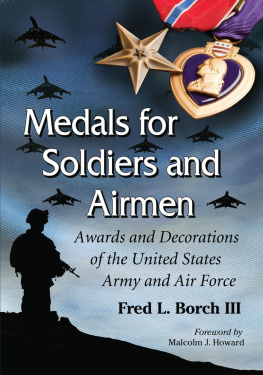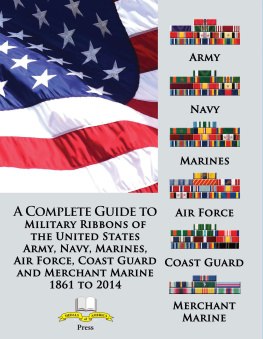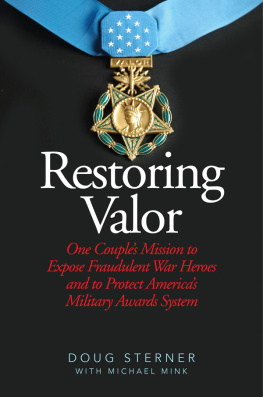
Medals for Soldiers and Airmen
Awards and Decorations of the United States Army and Air Force
Fred L. Borch III
Foreword by Malcolm J. Howard

McFarland & Company, Inc., Publishers
Jefferson, North Carolina, and London
LIBRARY OF CONGRESS CATALOGUING DATA ARE AVAILABLE
BRITISH LIBRARY CATALOGUING DATA ARE AVAILABLE
e-ISBN: 978-1-4766-0189-2
2013 Fred L. Borch III. All rights reserved
No part of this book may be reproduced or transmitted in any form or by any means, electronic or mechanical, including photocopying or recording, or by any information storage and retrieval system, without permission in writing from the publisher.
On the cover: medals, soldier silhouette, aircraft (iStockphoto/Thinkstock)
McFarland & Company, Inc., Publishers
Box 611, Jefferson, North Carolina 28640
www.mcfarlandpub.com
Foreword
by Malcolm J. Howard
When I entered the Army as a young West Point cadet in 1958, I knew very little about most of the medals and decorations that a soldier or airman might be awarded. Of course, I was well aware that Americas highest military award was the Medal of Honor. I knew that soldiers and airmen wounded in action were awarded the Purple Heart. Only after I began my Army career did I realize that the military has a variety of decorations and medals to recognize not only combat heroism, but also meritorious achievement and service performed by those who serve on the ground and in the air.
In Medals for Soldiers and Airmen: Awards and Decorations of the United States Army and Air Force, Fred L. Borch III has not only identied each of the personal decorations that a soldier and airman may be awarded today, but he also has provided the historical background for each award and some illustrative citations. You will learn that the Army has had a Medal of Honor since 1862, while the Air Force version of this famous decoration did not exist until 1965 and that, to date, only fourteen airmen have received it. Similarly, you will read about the Soldiers Medal and the Airmans Medalthe highest decorations that may be awarded to a soldier or an airman for non-combat valor.
The value of Medals for Soldiers and Airmen, however, is that it does not focus only on awards for gallantry in combat or other high level decorations. On the contrary, the book covers the full range of personal awards, from the Medal of Honor, Distinguished Service Cross and Air Force Cross to the Purple Heart, Meritorious Service Medal, and Air Force Commendation Medal. This means that the reader will be thrilled to read about the gallantry in action required for a Silver Star. But that same reader also will understand that the level of achievement or meritorious service required for an Army Achievement Medal is signicantand worthy of recognition.
Soldiering has always carried the positive connotation of self-sacrice for the good of our nation, our Army, and ones fellow soldiers. It is no different in the Air Force, where airmen focus on serving the nation, the Air Force and their fellow airmenand put their personal interests last. Decorations and medals exist to recognize this seless service by soldiers and airmenwhether in combat or peacetimeand this book is important because it highlights this truth.
Malcolm J. Howard, senior U.S. district court judge, Eastern District of North Carolina, graduated from the U.S. Military Academy in 1962 and served two tours in Vietnam. His decorations include the Silver Star, two Bronze Star Medals (one with V for valor device), the Meritorious Service Medal, two Air Medals and the Purple Heart.
Preface
This book is the rst comprehensive historical examination of all the personal awards, decorations and medals that may be awarded to soldiers and airmen.
Chapter 1 is a comprehensive history of Army and Air Force gallantry awards and covers in detail the Army and Air Force versions of the Medal of Honor, the Distinguished Service Cross and Air Force Cross, and Silver Star. Chapter 2 examines the Soldiers Medal and the Airmans Medalthe two decorations for non-combat valor in the Army and Air Force, respectively. Chapter 3 looks at the Distinguished Flying Cross, Bronze Star Medal and Air Medaldecorations intentionally created for both performance and valor. Chapter 4 is a detailed examination of fteen awards and decorations for outstanding achievement or meritorious service. These range from the Defense Distinguished Service Medal, Legion of Merit and Purple Heart to the Meritorious Service Medal, Aerial Achievement Medal and Air Force Commendation Medal.
Four appendices round out the book, and these include little-known information about the Oak Leaf Cluster, the V device, and the obsolete Certicate of Merit. There also is a bibliography listing selected books and articles of interest to historians and collectors.
Since this is a book about personal decorations to soldiers and airmen, I have tried to select photographs that highlight both Army and Air Force awardsand recipients. But I have intentionally avoided too many illustrations of common medals (which are readily available from other sources, especially on the Internet) and instead selected photographs depicting rare or unusual medals, such as Civil Warera Medals of Honor and the very rare reverse enameled Legion of Merit. I have also included some photographs of recipients and their medals because these put a face on what otherwise might be an impersonal study of decorations and medals.
A new medal, announced February 13, 2013, was to be included in this book. The Distinguished Service Medal, said Secretary of Defense Leon D. Panetta, was being established to recognize the extraordinary achievements of military personnel involved in the piloting of unmanned aerial vehicles (drones) and engaged in offensive and defensive information technology (cyber) operations.
Since these technologies have transformed the twenty-rst century battleeld, Panetta agreed with those in the Pentagon who argued that a special medal was needed to reward those who were making signicant contributions to military operations, even though they were not engaged in actual combat with an enemy.
Veterans groups and others criticized the decision. Some argued that a new medal simply was not needed, as existing military decorations were sufcient to recognize drone operators and cyber warriors. The more vocal critics were upset about the planned order of precedence for the medal, which Panetta had announced would be just behind the Distinguished Flying Cross. Since this meant that the new medal would outrank combat decorations like the Bronze Star Medal and Purple Heart, these critics argued that it was wrong for military personnel located far from the battleeld to receive a medal that outranked decorations for those in actual physical contact with the enemy.
New Secretary of Defense Charles T. Chuck Hagel called for a study and on April 15, 2013, announced that, with the concurrence of the Joint Chiefs of Staff and the service secretaries, he was eliminating the medal. The result: the Distinguished Warfare Medal is gone as a new decoration and gone from this book. In its place, according to Hagel, will be a new distinguishing device that can be afxed to existing medals and will recognize the achievements of men and women who directly affect combat operations without being present.
Next page











